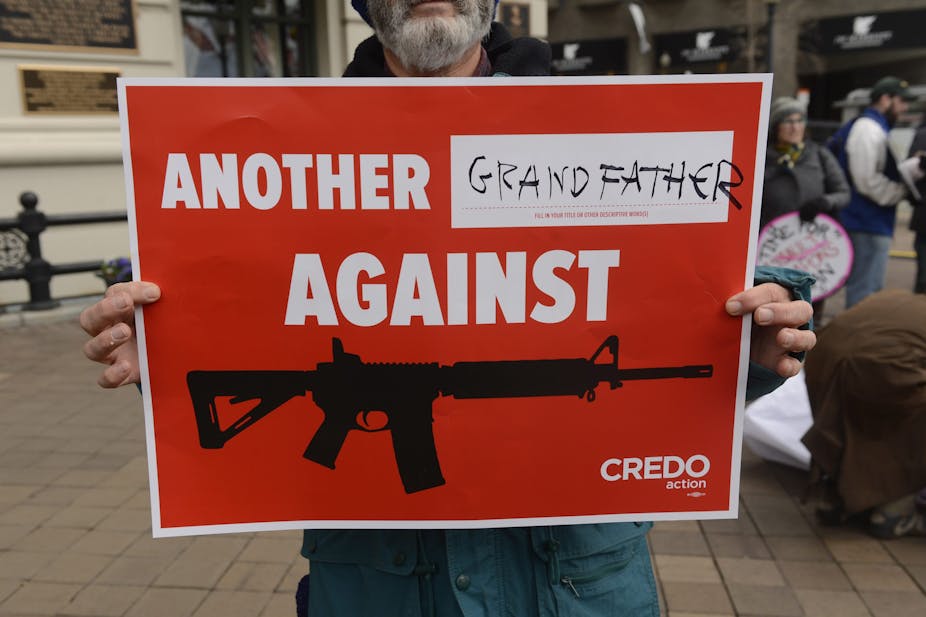The Sandy Hook massacre and President Obama’s response to it has refocused attention on impact of regulation on American gun crime. Crime statistics before and after the implementation of gun laws provide a quantifiable measure of their impact. As a consequence, Australia’s gun laws and their impact have become part of the American gun debate.
In the wake of the Port Arthur massacre and Monash University shootings, the conservative government of John Howard introduced a series of gun laws. These restricted who could own guns and the type of guns they could own.
While the impact of the Australian gun laws is still debated, there have been large decreases in the number of firearm suicides and the number of firearm homicides in Australia. Homicide rates in Australia are only 1.2 per 100,000 people, with less than 15% of these resulting from firearms.
Prior to the implementation of the gun laws, 112 people were killed in 11 mass shootings. Since the implementation of the gun laws, no comparable gun massacres have occurred in Australia.
Remarkably, American pro-gun advocates try to use the impact of the Australian gun law reform to make a case that reform “doesn’t work”. This seems amazing given the homicide rate in the United States is five per 100,000 people, with most homicides involving firearms.
When gun advocates use Australian crime stats, they sometimes employ a number of misleading tricks and sleights of hand. These tricks are common to several politically charged debates, and are a form of pseudo-science. Let’s look at these tricks in action.
Cherry picking
The selective use of data, or cherry picking, is a commonly used method of extracting the “right” answer. This is true even when all the data tells a completely different story.
Cherry picking often exploits random fluctuations in data. Firearm deaths in Australia have declined over the past two decades, but from year-to-year one can see variations up and down. Bigger fractional fluctuations are likely if you shrink your sample size.
Leading US pro-gun lobby group the National Rifle Association (NRA) was cherry picking when its publication, NRA News, reported this statistic from New South Wales:
In the inner west, robberies committed with firearms skyrocketed more than 70% over the previous year, figures show.
Rather than giving the national trend over many years, the NRA chose one part, of one city, in one state and just two years of data. The NRA’s use of stats is misleading. Around Australia, robberies using firearms have declined from over 1500 per year in the 1990s to 1100 per year.
Look over there!
When the most relevant statistics give the “wrong” answer, advocates often switch to less relevant statistics that give the “right” answer.
In the Wall Street Journal, Joyce Lee Malcolm stated
In 2008, the Australian Institute of Criminology reported a decrease of 9% in homicides and a one-third decrease in armed robbery since the 1990s, but an increase of over 40% in assaults and 20% in sexual assaults.
The implication is gun control has increased assaults and sexual assaults. This is completely misleading.
Weapons (including knives) are only used in 13% of assaults and 2% of sexual assaults in Australia. Firearms are rarely the weapon used, and only 0.3% of assaults in New South Wales used firearms.
Firearm use is almost completely irrelevant to assault and sexual assault in Australia, and cannot be driving changes in these crimes. Suggesting otherwise is deceptive.

Logical fallacy
Logical fallacies are very common in charged political debates.
Homicide rates in both Australia and the US have varied for a number of reasons. Since the decline in the US occurred without effective gun controls, does this mean gun control is ineffective? No.
While some gun laws may be ineffective (laws with grandfather clauses, for example), it is wrong to conclude that all gun laws are ineffective. That’s like saying that because some cars are slow Datsuns, there cannot possibly be fast Ferraris.
Of course, this logical fallacy also ignores a gorilla in the room. Firearm deaths per capita in Australia are tiny compared to US firearm deaths per capita.
Making it up
If all else fails, there is a remarkably simple solution. Just make up some numbers. Over 300,000 people have recently viewed copies of an NRA tabloid infomercial which claims
[Australian] gun murders increased 19%.
This is just plain wrong.
However, inventing numbers is a remarkably effective approach, and isn’t limited to the internet. If you lie, how many people will check your numbers? If the lie is caught, how will that be communicated to your audience?
For the record, in Australia firearms are now used less in robberies, homicides and kidnappings than they were in the 1990s.
Back to reality
So what is the reality? Homicide and suicide rates have declined in Australia since the 1990s. Deaths results from firearms have plunged even more dramatically. In Australia, mass shootings similar to Port Arthur, Hoddle Street and Strathfield have not occurred for over a decade.
Is this the result of the gun laws introduced by the Howard government? While some (particularly gun advocates) dispute their impact, several studies conclude the laws have made a difference.
Claims that Australian gun laws have increased crime are pure spin and deception. They say more about American partisan politics than about the reality in Australia.

